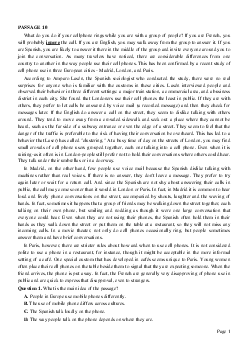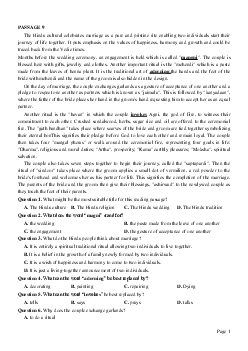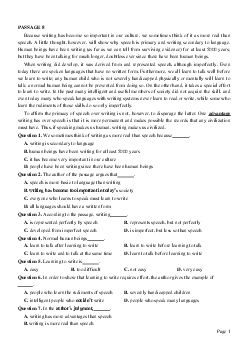


Preview text:
PASSAGE 11
If we believe that clothing has to do with covering the body, and costume with the choice of a
particular form of garment for a particular use, then we can say that clothing depend primarily on such
physical conditions as climate, health, and textile manufacture, whereas costume reflect social factors
such as religious beliefs, aesthetics, personal status, and the wish to be distinguished from or to emulate our fellows.
The ancient Greeks and the Chinese believed that we first covered our bodies for some physical reason
such as protecting ourselves from the weather elements. Ethnologists and psychologists have invoked
psychological reasons: modesty in the case of ancients, and taboo, magical influence and the desire to please for the moderns.
In early history, costume must have fulfilled a function beyond that of simple utility, perhaps through
some magical significance, investing primitive man with the attributes of other creatures. Ornaments
identified the wearer with animals, gods, heroes or other men. This identification remains symbolic in
more sophisticated societies. We should bear in mind that the theater has its distant origins in sacred
performances, and in all period children at play have worn disguises, so as to adapt gradually to adult life.
Costume helped inspire fear or impose authority. For a chieftain, costume embodied attributes
expressing his power, while a warrior’s costume enhanced his physical superiority and suggested he was
superhuman. In more recent times, professional or administrative costume has been devised to distinguish
the wearer and express personal or delegated authority; this purpose is seen clearly in the judge’s robes
and the police officer’s uniform. Costume denotes power, and since power is usually equated with wealth,
costume came to be an expression of social caste and material prosperity. Military uniform denotes rank
and is intended to intimidate, to protect the body and to express membership in a group. At the bottom of
the scale, there are such compulsory costumes as the convict’s uniform. Finally, costume can possess a
religious significance that combines various elements: an actual or symbolic identification with a god, the
desire to express this in earthly life, and the desire to enhance the wearer’s position of respect.
Question 1. Psychological reasons for wearing garments include
A. protection from cold
B. availability of materials
C. prevention of illness
D. wishing to give pleasure
Question 2. Why does the author mention the police officer’s uniform?
A. To identify the wearer with a hero
B. To illustrate the aesthetic function of costume
C. To suggest that police are superhuman
D. To show how costume signifies authority
Question 3. The passage mainly discusses costumes in term of its A. physical protection
B. religious significance C. social function
D. beauty and attractiveness
Question 4. What is the purpose of the paragraph 1?
A. To describe the uses of costume
B. To contrast costume with the clothing
C. To trade the origins of costume
D. To point out that clothing developed before costume
Question 5. The word “scale” in line 23 refers to
A. symbolic identification B. military rank Page 1 C. social position D. the balance
Question 6. Which of the following would most likely NOT be reflected in a person’s costume, as it is defined in the passage?
A. Having a heart condition
B. Playing in a baseball game
C. Working in a hospital
D. Participating in a religious ceremony
Question 7. It can be inferred from paragraph 3 that
A. The function of costume has become very sophisticated
B. Children like to identify with other creature by wearing costumes
C. Primitive people wore cloths only for sacred performances
D. Costume no longer fulfills a function beyond simple utility ĐÁP ÁN 1-D 2-D 3-C 4-B 5-C 6-A 7-B
LỜI GIẢI CHI TIẾT Question 1:
Lý do tâm lý cho việc mặc quần áo gồm:
A: Bảo vệ khỏi cái lạnh
B: Nguyên lvaatj liệu có sẵn C: Chống lại bệnh tật
D: Muốn có được sự thoải mái
Dẫn chứng: . Ethnologists and psychologists have invoked psychological reasons: modesty in the case of
ancients, and taboo, magical influence and the desire to please for the moderns. Question 2:
Tại sao tác giả lại đề cập đến đồng phục của cảnh sát ?
A: Để xác định người mặc là 1 anh hùng
B: Để minh họa cho chức năng thẩm mỹ của trang phục
C: Ý nói rằng cảnh sát là 1 người hùng
D: Thế hiện trang phục tượng trưng cho chính quyền như thế nào
Dẫn chứng: In more recent times, professional or administrative costume has been devised to distinguish
the wearer and express personal or delegated authority; this purpose is seen clearly in the judge’s robes
and the police officer’s uniform. Question 3:
Đoạn văn chủ yếu nói về khía cạnh nào của trang phuc?
A: Sự bảo vệ mang tính vật lý B: Ý nghĩa tâm linh C: Chức năng xã hội
D: Vẻ đẹp và sự hấp dẫn Page 2
Dẫn chứng: , whereas costume reflect social factors such as religious beliefs, aesthetics, personal status,
and the wish to be distinguished from or to emulate our fellows. Question 4:
Mục đích của đoạn 1 là?
A: Miêu tả chức năng của trang phục
B: So sánh trang phục với quần áo thông thường
C: Thương mại hóa nguồn gốc của trang phục
D: Chỉ ra rằng quần áo phát triển trước trang phục Question 5:
Từ “scale” ở dòng 23 chỉ ?
A: Xác định biểu tượng B: Bậc quân hàm C: Vị trí xã hội D: Sự cân bằng
Dẫn chứng: . At the bottom of the scale, there are such compulsory costumes as the convict’s uniform
Scale = social position: giai cấp, vị trí xã hội Question 6:
Cái nào sau đây không có khả năng được phản ánh về trang phục như được nói trong đoạn văn ? A: Có vấn đề về tim B: Chơi bóng chày
C: Làm việc trong bệnh viện
D: Tham gia vào một buổi lễ tôn giáo Question 7:
A: Chức năng của trang phục vô cùng phức tạp
B: Trẻ con thích phân biệt với người khác bằng việc mặc trang phục
C: Người nguyên thủy mặc quần áo chỉ trong những buổi biểu diễn thiêng liêng
D: Trang phục chkhoog có những chức năng gì ngoài những tiện ích đơn giản
Dẫn chứng: . We should bear in mind that the theater has its distant origins in sacred performances, and in
all period children at play have worn disguises, so as to adapt gradually to adult life. Page 3



